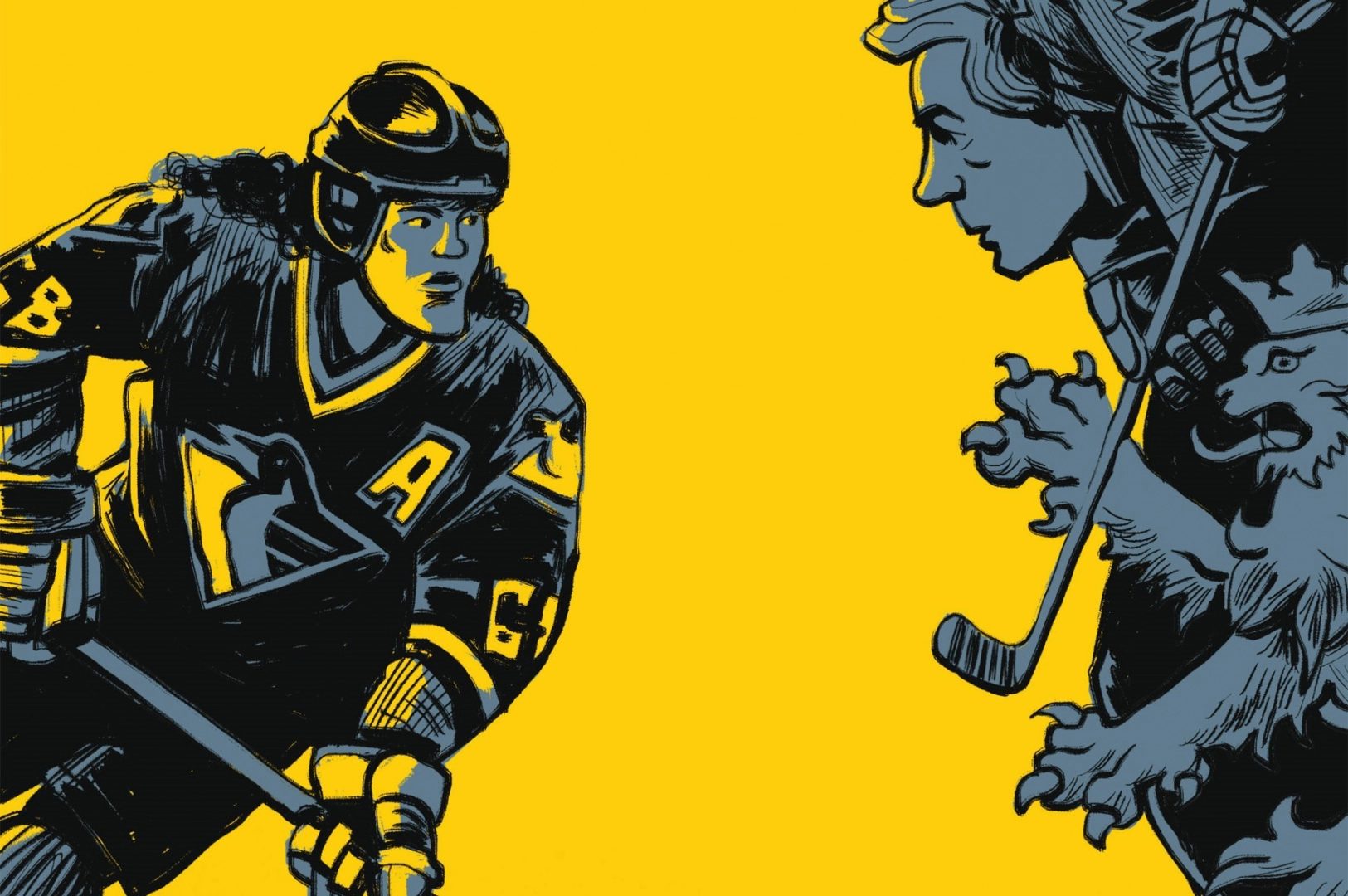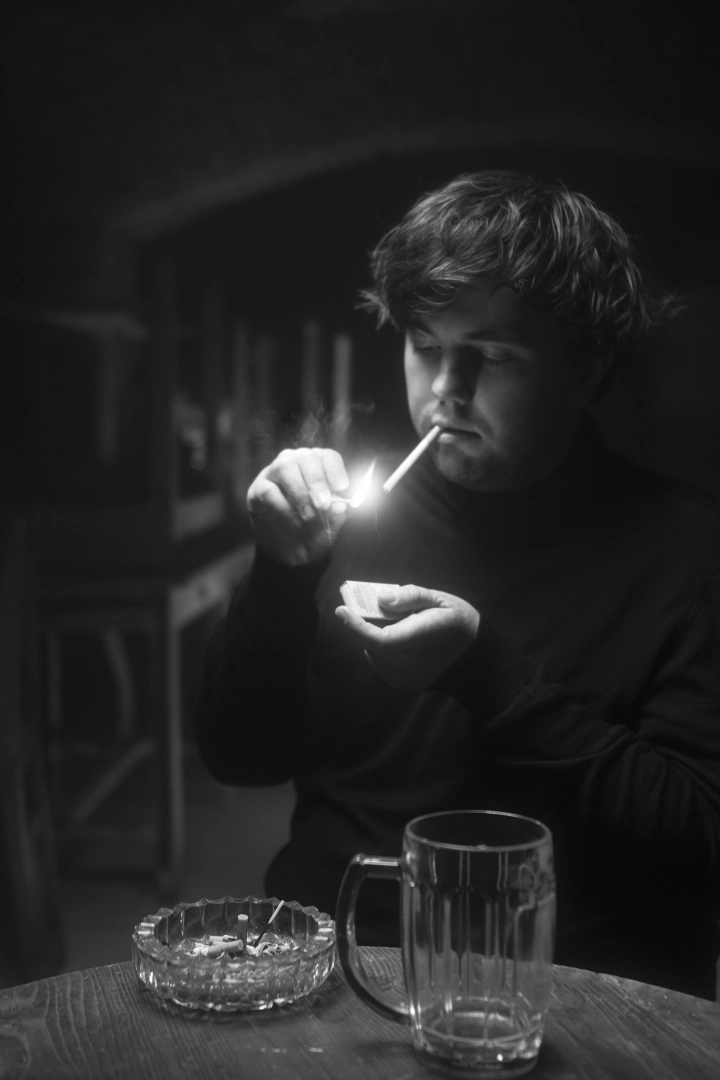Lukáš Csicsely (1989) comes from Zliv near České Budějovice, he graduated in esthetics and film studies from the Charles University in Prague and in scriptwriting from the Film and TV School of Academy of Performing Arts in Prague (FAMU). He has written a number of radio, film, and comic book scripts as well as books for adults and children. Four of his children’s books were selected for the project Best Books to Children by the Association of Czech Booksellers and Publishers and the Czech section of IBBY. In cooperation with the visual artist Vojtěch Šeda he created a comic book Jágr, the Legend about the life and career of Jaromír Jágr. The entire book has taken up the style of a chivalric legend and is published by the 65. pole publishing house.
Could you outline what motivated you to create a comic about Jaromír Jágr?
It was Tomáš, the publisher from 65. pole, who came with the first impulse. His friends used to make a periodical one-page comic about Jágr for the Czech mutation of Newsweek, but they didn’t have time for a book. That’s why he’d approached me and as I had a personal relationship to the matter, I agreed and reached out to Vojta (the illustrator). I’m from a small town, just like him, where many played Jágr or Hašek when we were children, but only a few of them became famous hockey players. It is such “unfortunates” that the book is dedicated to. I found it amusing to give our childhood superhero a comic book form. We put together a story based on real-life events but used the plot of a chivalric legend – I like playing with genres.
Didn’t you worry that you’d “touch” the people’s idol? The comic depicts the beginnings of Jágr’s career, which aren’t too controversial, you also avoid mentioning his partners, but anyway...
“The lower controversy level” has to do with the genre selection, which is given away by the book title itself – its essence is in building a myth. I wasn’t worried, the expectations differ when it comes to widely known personas, they’re sometimes very specific and above all often contradictory... it would be foolish to hope it will please many. Still, the power of Jágr's idol was apparent. For example, Tomáš would sometimes oppose depicting Jágr tired or ill during the comic consultations. It’s important to mention that the comic book isn’t about the person himself, but about his image that was created by the audience and media. And this creature, character, or “image” is something remarkable.
.jpg)
In addition, you mentioned you might write a sequel dealing with the era since 2001 – aren’t you worried? Do you have any idea where Dave (the more critical and contemplative of the comic guides) could go?
It would be a pandanus, or “a paired image” of the first part. While that one depicted Jágr in line with the legend genre, like a homogenous, even one-dimensional figure, the second part should deal with his ambiguities, unclarity, and contradictions, which are very human at the same time. I personally am not worried about the result; what I’m worried about is that we won’t be able to find funding for the book.
Andy and Dave are the guides in the comic – how did you go about creating their characters? Did you put your thoughts in their mouths as well or are they supposed to function more like certain types?
Andy and Dave, to a certain extent, are like angel and devil watching Jágr’s life – meaning they often have extreme opinions potentially creating tensions – while one of them always sees the bright side, the other one is snippy, cynical, analyzing, but here he is rather in the background... anyway, neither of them leaves their commentator role. Maybe in the next part I might let them leave these roles and become full-fledged characters, at least on them.
%20(1)%20(1).jpg)
What was the preparation for writing the script actually like? Did you consult with any “jágrlogist”, or did you make your own research?
I researched lots of material from books to documentaries, newspaper articles and hockey league statistics archives. I became a jágrlogist myself for a while. Sometimes I get asked about personal communication with Jágr, but since it is a legend, not a biography, it maybe might have been detrimental. Nevertheless, I consulted the factual side with the Czech sports reporter Marek Burkert.
Jiří Hrdina, Mario Lemieux, Martin Straka, Marian Jelínek and others have pivotal roles in the comic – do you think you managed to cover all the most important people who had influenced Jágr in that era or was it a selective choice?
Selection was necessary in general. I had available only about hundred pages of the comic, so I had to find a coherent whole and what I found appropriate was Jágr’s Pittsburg era finished with the symbolic year 2001 which was then the peak moment for Czech hockey (according to the number of medals, awards for Czech players in NHF and the number of Czechs in drafts, too.) Then I used the abovementioned commentators to enrich the smaller number of pages. The selection of the characters was given by the story’s topic which I saw as an initiation: Pittsburgh acquired Jiří Hrdina as a support for Jarda’s first seasons; Jágr then adopted that role for Straka. Marian Jelínek is the middleman of the search for spirituality. And Mario is the most important character, whose relationship with Jágr maintains the basic line of the story, who changes from a child’s idol (he saw him at the 1985 World Championship in Prague) to a team player with whom he forms the NHL’s most striking duo; then into an ill man who leaves Jarda, when he’s not yet ready, to lead the whole team; into the owner of the club where Jágr is at first the core member, later a financial burden which needs to be got rid off.
To approach the chivalric legend genre, the teams playing in the play off against Járg’s Pittsburgh are depicted in animal forms. Which logo/mascot of the NHL teams do you yourself like the best?
If we’re only talking jerseys, these days I enjoy the look at Tampa Bay or Rangers, Boston’s jerseys arouse passion because I’m a fan and Buffalo’s jersey evoke nostalgia because as a child I adored Hašek.
.jpg)
Will the eventual sequel stick to the chivalric legend genre, or will you try something else?
It would definitely be a different genre whose selection relates to the narrator’s prominence, in this case Dave’s, and in accordance with the abovementioned themes also a darker one.
The comic focuses on Jágr’s spirituality a lot, do you think he’d have been a different hockey player hadn’t it been for that aspect?
That’s for sure, he himself says it’s only thanks to his faith that he’s still playing at the age of fifty, while others claim he only prays to score goal and there’s no spirituality involved.
The book was christened by Michal Dusík, if I’m not mistaken. What does the professional hockey community actually say about the book?
Dusík himself praised it and recalled how he’d meet Jágr at junior matches. Hockey websites reported on it and the representatives on youth teams were buying it for their teams.
In their time, the popularity of Jaromír Jágr might have been approached (maybe even surpassed) by Dominik Hašek. Do you think that any of the contemporary hockey players could get close to that in the future?
I think their situation was extraordinary and it was related to the time when, for the first time, Czechs were able to enter the NHL as youngsters (during communism only after thirty). Juraj Slafkovský may experience similar popularity with his extraordinary “first time” as the number one overall pick in this year’s draft in Slovakia. Pastrňák is great, but in general our hockey isn’t in the best shape nowadays, which doesn’t mean it doesn’t bring nice stories... I really like the one about Rutt and Palát setting out to nearby towns (Janovice and Písek) where Kubina and Neckář brought the Stanley Cup they’d won with Tampa Bay, only to go back to the same places with the same cup won with the very same team a few years later. For me, the hockey world is like a light-hearted fairytale world which smells like childhood.
You yourself write a lot of books for children. Comics have been considered “reading for children” for many years, how did you find your way to it?
Children’s literature is specific in that it’s written by adults for children and, on top of that, it’s usually the adults who pick the books for them. Maybe it should be done more by children for children... I say that I wrote the comic for my twelve-year-old self. I didn’t read at that time, I don’t come from a cultural family, I was playing games, reading magazines; I’ve taken up books only when I was eighteen, but with all the more gusto. Comic seemed like the ideal choice for the Jágr theme because it may appeal to non-readers (and maybe show them the way to reading) and take some, who played this superhero, a few years back in time.

%20(1).jpg)




